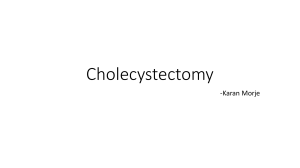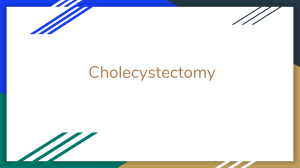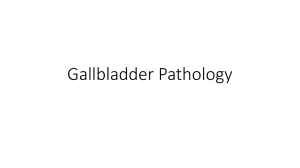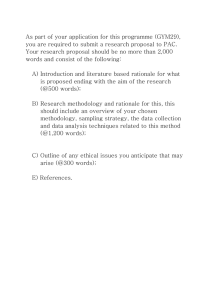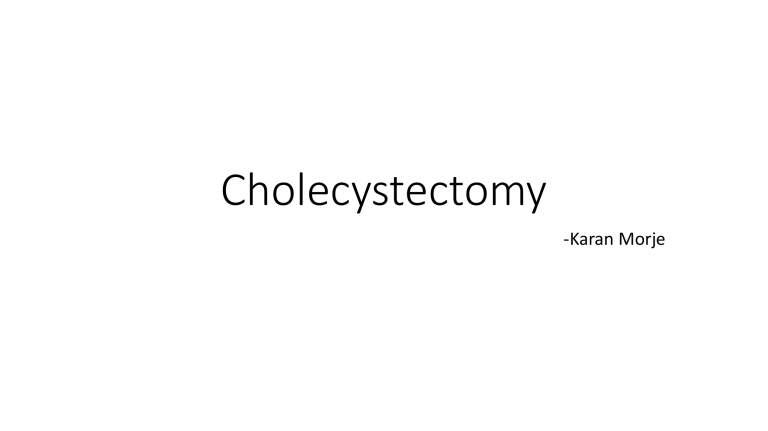
Cholecystectomy -Karan Morje What Is Cholecystectomy? • A cholecystectomy is the surgical removal of the gallbladder, an organ located just under the liver on the upper right quadrant of the abdomen. • The gallbladder stores and concentrates bile, a substance produced by the liver and used to break down fat for digestion. Indications • Cholecystectomy is used to treat gallstones and the complications they cause. • Your doctor may recommend cholecystectomy if you have: • Gallstones in the gallbladder (cholelithiasis) • Gallstones in the bile duct (choledocholithiasis) • Gallbladder inflammation (cholecystitis) • Pancreas inflammation (pancreatitis) Indications • Several conditions may lead to surgery to remove the gallbladder. Conditions that may require open rather than laparoscopic surgery include: • Severe inflammation of the bile duct or gallbladder. 1. Inflammation of the abdominal lining(peritonitis). 2. High pressure in blood vessels in the liver (portal hypertension). This is caused by cirrhosis of the liver. 3. Being in the third trimester of pregnancy. 4. A major bleeding disorder or use of medicines to prevent blood clotting (blood thinners) Types Of Cholecystectomy • Laparoscopic Cholecystectomy This procedure uses at least three to four small incisions and three or more laparoscopes—small thin tubes with video cameras attached—to visualize the inside of the abdomen during the operation. The surgeon performs the surgery while looking at a TV monitor. The gallbladder is removed through one of the incision. Types Of Cholecystectomy • Open Cholecystectomy In this method, a two- to three-inch incision is made in the upper right-hand side of the abdomen. The surgeon locates the gallbladder and removes it through the incision. Gases Used for insufflation. • Air , Oxygen- Easily Available, Inexpensive but supports Combustion • Nitrogen- Does not support combustion, poorly absorbed, low blood solubility, gas embolism • Nitrous Oxide- beneficial for pts under regional anaesthesia, supports combustion • Helium-Poorly absorbed, low blood solubility, Not cost effective • Argon-Poorly absorbed, low blood solubility, Not cost effective • Carbon Dioxide- Does not support combustion (most commonly used) Absorbed in large quantities Type of Anaesthesia • Most open cholecystectomies are performed under general anaesthesia. • Pre-medication: Glycopyrrolate (200 mcg/ kg) + Midazolam, PONV: Emset, Antacid: Ranitidine • Inhalation agents: Sevoflurane/ Isoflurane • Induction agents: Propofol (2 mg/kg) • Muscle Relaxants: Vecurronium (0.15 mg/kg)/ Atraccurrium (0.6 mg/kg) • Narcotics: Fentanyl (1mcg/kg)/ remifentanil • Reversal: Neostigmine + Glycopyrrolatre (2.5 mg/kg + 500 mcg/kg) • Less common alternatives include regional (epidural or spinal) and, rarely, local anaesthesia. Positioning • Monitoring Done under supine position. ( SpO2, B.P, E.C.G, EtCO2) • Patients are positioned supine with arms extended. Placing a folded blanket or bump underneath the patient's right back or inverting the table may be beneficial. Complications • • • • • • • • • • May be related to Pain Muscular impairment Decreased energy/fatigue Possibly evidenced by Tachypnea; respiratory depth changes, reduced vital capacity Holding breath; reluctance to cough Desired Outcomes Establish effective breathing pattern. Experience no signs of respiratory compromise/complications. Post-op Management • Observe the color and character of the drainage. • Rationale: Initially, drainage may contain blood and bloodstained fluid,normally changing to greenish brown (bile color) after the first several hours. • Change dressings as often as necessary. Clean the skin with soap and water. Use sterile petroleum jelly gauze, zinc oxide, or karaya powder around the incision. • Rationale: Keeps the skin around the incision clean and provides a barrier to protect skin from excoriation. • Apply Montgomery straps. • Rationale: Facilitates frequent dressing changes and minimizes skin trauma. • Use a disposable ostomy bag over a stab wound drain. • Rationale: Ostomy appliance may be used to collect heavy drainage for more accurate measurement of output and protection of the skin. • Place patient in low- or semi-Fowler’s position. • Rationale: Facilitates drainage of bile. Post-op care • Have patient use cotton/sponge swabs and mouthwash instead of a toothbrush. • Rationale: Avoids trauma and bleeding of the gums. • Monitor laboratory studies, e.g., Hb/Hct, electrolytes, prothrombin level/clotting time. • Rationale: Provides information about circulating volume, electrolyte balance, and adequacy of clotting factors. • Administer IV fluids, blood products, as indicated;Electrolytes; Vitamin K. • Rationale: Maintains adequate circulating volume and aids in replacement of clotting factors. • Corrects imbalances resulting from excessive gastric/wound losses. Provides replacement of factors necessary for clotting process. THANK YOU
